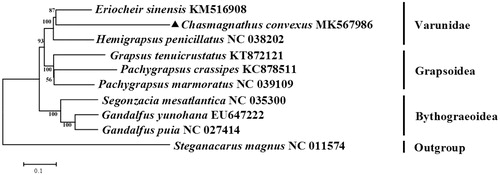Abstract
The complete mitochondrial genome of the Chasmagnathus convexus has been determined in this study. The complete genome (mtDNA) was 15,107 bp in length and contained 13 protein-coding genes, 1 rRNA genes, and 22 tRNA genes. The overall base composition of the genome in descending order was 34.2% T, 32.8% A, 20.9% C, and 12.1% G. In 13 protein-coding genes, most of the protein-coding genes start with ATG (COX1, COX2, COX3 and ATP8) and ATT (NAD5, NAD4, NAD4L, NAD6, ATP6 and NAD2), only CYTB, NAD3, and NAD1 genes start with ATA. For the stop codon, only NAD2 end with TAG, the other 12 genes end with TAA. Phylogenetic analysis indicated that C. convexus is closely related to Hemigrapsus penicillatus family. It would be a supplement for the genetic analysis of C. convexus and promote the phylogenesis of Grapsidae.
Chasmagnathus convexus, is a common crab species of the family Grapsidae. (Shih and Suzuki Citation2008). In Japan, this crab is commonly called hamagani (Ng et al. Citation2008). It is distributed across Hainan island, Taiwan, Zhejiang, and other places in the Chinese mainland. This crab has two forms that differ in color, one is olive green and the other is purple (Gray et al. Citation1850). Differences in diet are believed to be responsible for the color variation between the two forms C. convexus is large, relative to the other related crabs, and can reach 4.5–5.0 cm wide across its carapace (Miyasaka et al. Citation2007).
Here, for the first time, the complete mitochondrial genome of C. convexus has been determined. The specimen of C. convexus was collected in Zhejiang province, China (122.2°E, 30.3°N) and identified by morphology and deposited in National Engineering Research Center for Marine Aquaculture, Marine Science and Technology College, Zhejiang Ocean University. The total DNA extraction was achieved utilizing the salting-out method (Aljanabi and Martinez Citation1997) with the muscle. The Illumina HiSeq X Ten platform was used to perform the high-throughput sequence.
The complete mitochondrial genome of C. convexus is 15,107 bp in length (GenBank accession number: M567986). The complete mitochondrial genome has 13 protein-coding genes, 1 ribosomal RNA genes, and 22 transfer RNA genes (tRNA). The nucleotide composition for C. convexus is 32.8% A, 34.2% T, 20.9% C, and 12.1% G. In 13 protein-coding genes, most of the protein-coding genes start with ATG (COX1, COX2, COX3, and ATP8) and ATT (NAD5, NAD4, NAD4L, NAD6, ATP6 and NAD2), only CYTB, NAD3, and NAD1 genes start with ATA. For the stop codon, only NAD2 end with TAG, the other 12 genes end with TAA.
The phylogenetic tree () was constructed based on 13 protein-coding genes of 10 species using the Neighbor-joining method in the program Phylip (Felsenstein Citation1989). The tree showed that C. convexus is closely related to Hemigrapsus penicillatus. We believe that this result will further supplement the genome information in mitochondria of the family Grapsidae and facilitate the study on population genetic.
Disclosure statement
The authors report no conflicts of interest. The authors alone are responsible for the content and writing of the paper.
Additional information
Funding
References
- Aljanabi SM, Martinez I. 1997. Universal and rapid salt-extraction of high quality genomic DNA for PCR-based techniques. Nucl Acids Res. 25:4692–4693.
- Felsenstein J. 1989. PHYLIP-Phylogeny inference package (Version 3.2). Cladistics. 5:164–166.
- Gray JE, Richardson J, Adams A, Reeve L. 1850. The zoology of the voyage of HMS Samarang: under the command of Captain Sir Edward Belcher. London, UK: Reeve & Benham.
- Miyasaka H, Genkai-Kato M, Goda Y, Omori K. 2007. Length-weight relationships of two varunid crab species, Helice tridens and Chasmagnathus convexus, in Japan. Limnology. 8:81–83.
- Ng PK, Guinot D, Davie PJ. 2008. Systema Brachyurorum: Part I. An annotated checklist of extant brachyuran crabs of the world. Raffles Bull Zool. 17:1–286.
- Shih H-T, Suzuki H. 2008. Taxonomy, phylogeny, and biogeography of the endemic mudflat crab Helice/Chasmagnathus complex (Crustacea: Brachyura: Varunidae) from east Asia. Zoological Studies-Taipei. 47:114.

